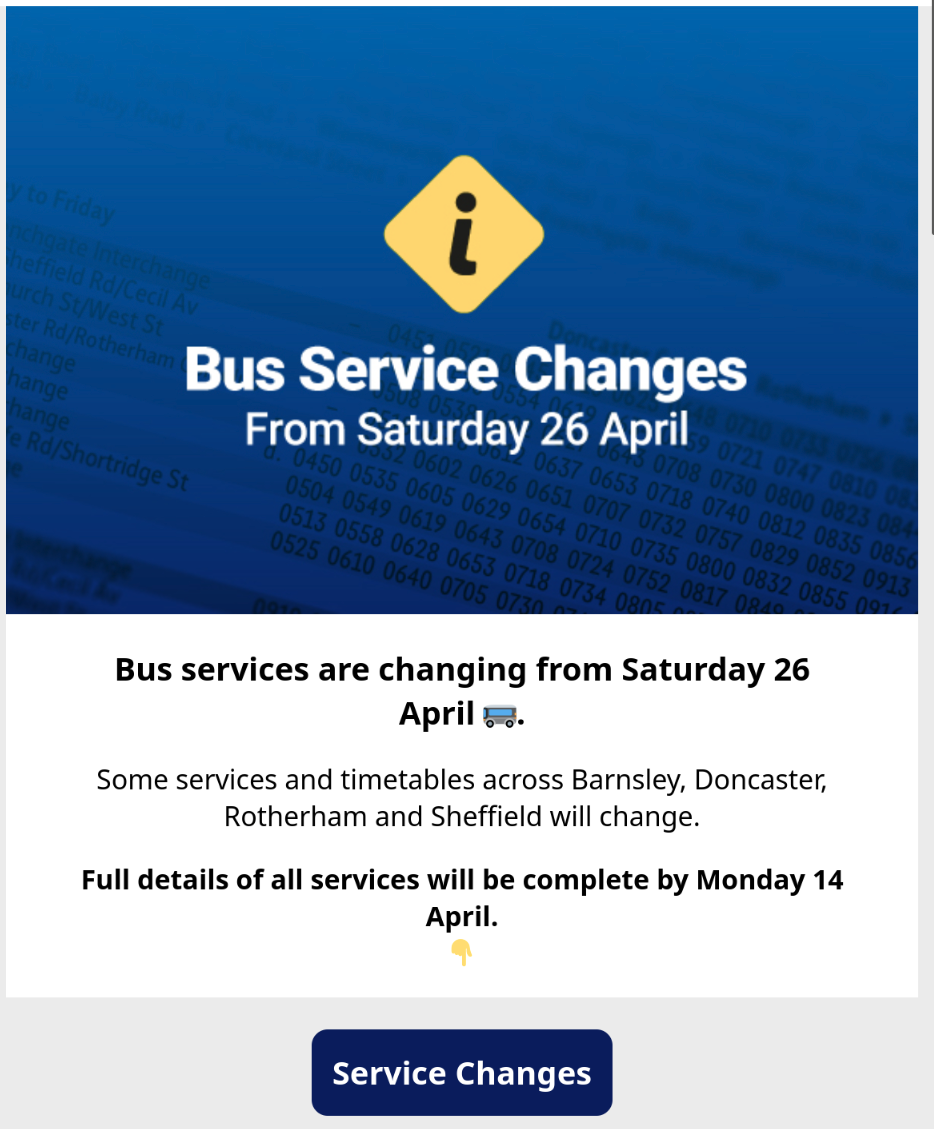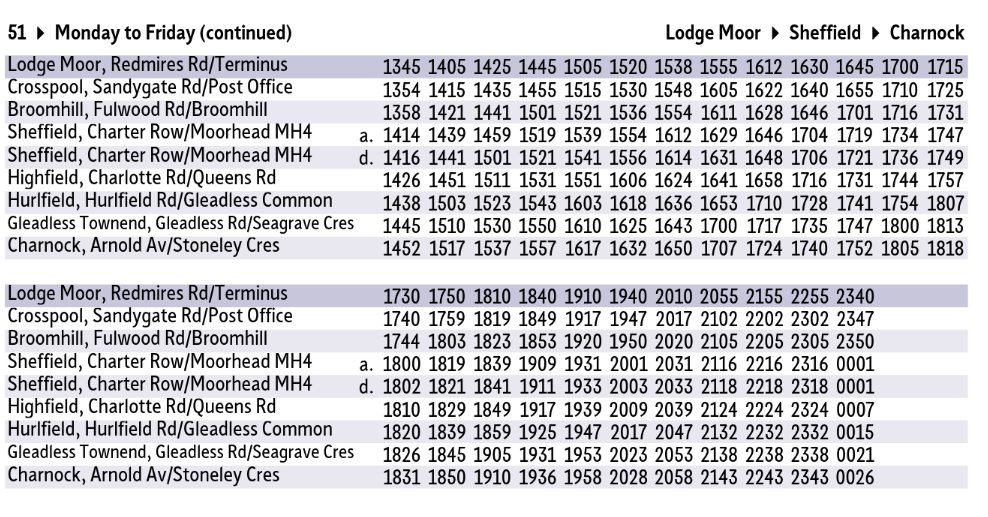Travel South Yorkshire's unhelpful service change information
There are timetable changes.
Most urban areas in the UK have a Passenger Transport Executive, a branch of local government that coordinates public transport with the area. Anyone even remotely familiar with the organisational structure of transport in the United Kingdom - at least outside of London and Manchester - knows that this is an unenviable task: transport services and associated responsibilities are split between many disparate organisations with vastly different approaches and priorities and as such, one has to treat the PTEs with a fair amount of patience as they try to bring the whole mess together into something vaguely usable.
I say this to emphasise that I have nothing against the people at Travel South Yorkshire - which, as the name suggests, is the PTE for the South Yorkshire region1, encompassing Sheffield, Doncaster, Rotherham and Barnsley. South Yorkshire is served by around a dozen bus companies and four separate borough councils, and of course it will be facing the same financial pressures as other local authorities, which will impair its ability to carry out its function effectively. Some might say it’s a miracle that they manage to produce any coordinated information at all, and I’m glad that they at least seem to try.
That said, the information that TSY is providing on its website about the upcoming round of bus timetable changes - on the last weekend of April 2025 - is of incredibly poor quality and, in at least one case, grossly misleading. That is what this post is about.
I first found out about this round of timetable changes from an entry in TSY’s email newsletter, as follows:

To give credit where credit is due, this is clear and unambiguous, and there is a direct link to more detailed information. That link leads to TSY’s Service Changes page (archived version from the time of writing if you’re reading this much later on). The first thing you are presented with in the “Bus service changes section” is this explanation of what a “timing point” is:
A timing point is a specific stop on the route of a service where the bus should depart at a particular time. If the bus driver is early on their route, they will wait at a timing point until the set departure time, helping to keep them to schedule.
Buses will still call at other stops on the route, but there isn’t a particular time that they should depart those stops, just an estimate. These estimates can vary, which is why we only show timing points on our timetable downloads.
This is a reasonably good explanation, and well placed, considering plenty of services are changing timing points. So far, so good.
Unfortunately, things start to go downhill rather quickly.
Seventy-eight sixes
The first problem that becomes apparent is that every upcoming bus timetable change across South Yorkshire - and even a few that have already happened - are just put into a gargantuan list which is broken up only by borough and has lno search function. Clearly it’s possible to use the “find” function in the web browser, but often that is barely any use.
As an extreme example, suppose you need to look up changes to Sheffield route 6. Searching for ‘6’ gives, as well as the route you actually want:
- Barnsley route 6, which has nothing to do with Sheffield route 6
- thirty-nine further occurences of otherwise unrelated route numbers that just happen to contain the digit ‘6’
- thirty-six occurrences of the number 26 as part of a date (which is entirely unsurprising, considering many of the changes are taking place on the 26th April and some previous changes from the 26th March are still displayed)
- an outdated section about Transpennine Express timetable changes from 16th December 2024.
It’s not the worst UI problem in the world, but it does make finding a specific route quite challenging, especially if it has a single-digit number.
A similarly frustrating problem is the “Change Description” column. It is presumably supposed to contain a quick summary of the changes, but in most cases it simply contains the phrase “From [26/27] April there will be timetable changes”. I suppose that might reassure passengers that the route isn’t being totally removed, but it’s not much help beyond that. “Timetable changes” could mean anything from some minor tweaks by a few minutes here and there to a total rewriting of the timetable.
For contrast, here is what Transport for Greater Manchester says about their upcoming changes to Manchester route 35:
From Sunday 27 April, there will be minor changes to the times of most Monday to Saturday journeys to improve reliability.
This isn’t vastly more detailed, but it’s vastly more helpful. A little goes a long way: from that, a regular passenger on the 35 knows at a glance that they should probably double-check the timetable to make sure they don’t miss their bus, but any change is likely only by a few minutes so they won’t have to make too much of a change their routine.
The Mystery of the Additional Journeys
Let’s change perspective a bit, by looking at a specific route: Sheffield’s 51. Here is what Travel South Yorkshire has to say about it:

Additional journeys! That sounds positive, doesn’t it? Let’s click the prominent “View more information” link, which leads to route 51’s designated page (archived). That reveals some more detailed information:

That might raise some eyebrows among those familiar with the 51 timetable. The 51 currently operates every 15 minutes during those times, so 20 minutes would represent a reduction in the number of journeys.
But of course, it’s not that simple. Here, again, is description of the promised “additional journeys”:
During weekday afternoon peak times there will be additional journeys between Sheffield and Charnock.
Here is the afternoon part of the old timetable (before 27th April):

and here is the afternoon part of the new timetable (after 27th April):

So let’s compare the weekday afternoon peak timetable between Sheffield and Charnock. I’m defining the first afternoon peak service as the 15:05 departure from Lodge Moor, since that’s when they seemingly deem there is enough demand for the new timetable to return from its reduced 20 minute frequency to approximately a 15 minute one. This is probably fairly accurate - just after 3pm is when buses do tend to start getting busier in the afternoon, first with travel home from school, and then remaining so for much of the rest of the day as people travel home from work, then out for the evening.
Similarly, I’m defining the end of the evening peak as the last bus before 8pm departure from Lodge Moor, after which both timetables revert more or less to an hourly frequency for the rest of the evening.
Using this definition, departures from Sheffield Moorhead to Charnock are at:
- in the old timetable: 15:41, 15:56, 16:14, 16:31, 16:48, 17:06, 17:21, 17:36, 17:49, 18:04, 18:24, 18:44, 19:04, 19:18 and 20:16
- in the new timetable: 15:41, 15:56, 16:14, 16:31, 16:48, 17:06, 17:21, 17:36, 17:49, 18:02, 18:21, 18:41, 19:11, 19:33 and 20:03.
Astute readers may notice that the number of journeys is exactly the same - 15 in both timetables!
Perhaps my definition is wrong. Let’s choose a different definition of the evening peak - the one generally used by Northern Trains, whch is services that depart the origin on the passenger’s ticket between 16:01 and 18:29.
So here are the departure times of all 51s to Charnock departing Sheffield Moorhead in that window:
- in the old timetable: 16:14, 16:31, 16:48, 17:06, 17:21, 17:36, 17:51, 18:06, 18:24
- in the new timetable: 16:14, 16:31, 16:48, 17:04, 17:19, 17:34, 17:47, 18:02, 18:21
Once again, it’s exactly the same number of journeys, at almost exactly the same times.
And just for fun, I counted the total number of journeys on the 51 throughout the whole day (I’ll spare you a list of them all).
- in the old timetable: 522
- in the new timetable: 50
So what TSY describes in some places simply as “additional journeys” and in other places as “additional journeys in the afternoon peak period” actually means two less journeys overall, and exactly the same number of journeys in the afternoon peak period.
The mind boggles. But it gets even worse. I know, this is riveting stuff that you can hardly wait for - but tune into this blog3 at a later date to find out about the almighty mess that has been made of the 95 service.
-
Actually, Travel South Yorkshire is no longer officially a PTE - it was at one point, but its responsibilities have been absorbed by the South Yorkshire Mayoral Combined Authority, and TSY is now just a brand name used by SYMCA and not an organisation in its own right. But all the functions TSY had when it was a PTE are now carried out by the SYMCA under the TSY brand, so for these purposes, it’s very much business as usual. ↩
-
This isn’t including two journeys in the old timetable that only run as far as Olive Grove bus depot and not as far as Charnock. There are no such journeys in the new timetable, and it’s easy to see that someone might have heard “no more afternoon peak journeys terminate short of Charnock” and incorrectly assumed that to mean “more afternoon peak journeys run to Charnock”. But that doesn’t make it any less incorrect, and it still doesn’t explain why they have published the misleading “additional journeys” description on the summary page when the number of journeys has actually reduced. ↩
-
Is a blog something one actually “tunes into”? ↩